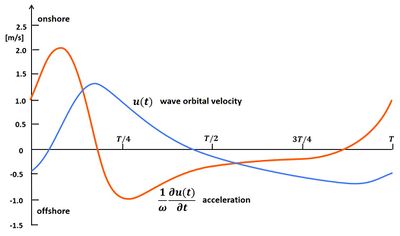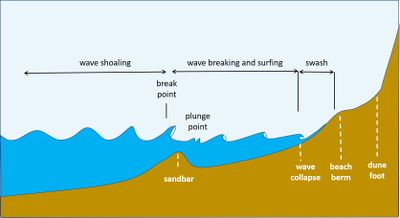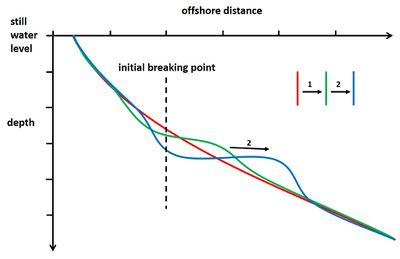Nearshore sandbars
It is recommended to read this article in conjunction with the article Shoreface profile.
Contents
Introduction
Nearshore sandbars, also called breaker bars, are a common feature of the surf zone of sandy coasts worldwide. They are the result of the dynamic interaction between the shape of the coastal profile and the transformation of waves as they propagate onshore; at the same time they are an important agent in this interaction[1]. Their presence promotes the breaking of waves further away from the shoreline; they thus reduce the wave forces exerted directly on the shore[2]. The cartoon of Fig. 1 shows a typical example of the transformation and breaking of incident waves in the nearshore zone.
Bar formation
The process of bar formation is still a topic of research. Observations suggest that bar formation is related to the prevalence of onshore sand transport by incident waves before breaking and the prevalence of offshore transport after breaking[3]. Because there is no prevalence in an equilibrium situation, this must be understood as follows. Under intensifying incident waves, a small positive perturbation of the equilibrium seabed profile (small hump) in the shoaling zone (i.e. before breaking) will migrate in onshore direction, whereas a small positive perturbation in the surf zone (i.e. after breaking) will migrate in offshore direction[4][5]. Onshore transport prior to breaking is mainly due to the interaction of the shoaling wave with the seabed that generates higher velocities and stronger acceleration of onshore wave orbital motion compared to offshore wave orbital motion[6][7] (Fig. 2). Offshore transport is mainly due to wave breaking that produces strong turbulence and uplift of sand from the seabed that is transported seaward by so-called undertow (the return flow in the lower part of the water column compensating for the onshore mass transport in the upper part of the water column between wave trough and crest)[8][9][10]. See Shoreface profile for more explanations.
Laboratory experiments[11][12] and process-based morphodynamic modeling[13][14] show that nearshore sandbars can develop as a result of wave breaking on the shoreface. Waves breaking on a non-barred shoreface induce a net seaward sand transport caused by the undertow current in a zone landward of the breakpoint. Sediment mobilization in this zone (which can be enhanced by seabed stirring due to longshore currents induced by obliquely incident breaking waves) is largely responsible for the strength of this seaward sand transport[15][16]. Wave breaking will thus initiate a bar by creating a trough at the breakpoint and a hump seaward of the breakpoint (assuming that the shoreface slope seaward of the breakpoint is in equilibrium). The breakpoint will then move seawards and the initial bar will follow until reaching a position further down the shoreface slope where the breaker-induced offshore sand transport is weakened and in equilibrium with wave-induced onshore transport (Fig. 3). This mechanism illustrates that shorefaces subject to vigorous wave breaking will usually exhibit a barred profile. In situations of less intense wave breaking the bar will not grow high, but take the form of a terrace[17][18].
 Fig. 2. Onshore-offshore asymmetry of the wave orbital velocity and acceleration in the shoaling zone. The maximum onshore orbital velocity in the wave crest phase is substantially larger than the maximum offshore orbital velocity in the wave trough phase (sometimes called positive skewness). The acceleration of offshore to onshore wave orbital velocities is also substantially larger than the acceleration in the opposite direction (sometimes called positive asymmetry). In most cases this will induce net onshore sand transport, although in some cases the opposite may also happen (see Sediment transport formulas for the coastal environment). |
Bar migration

Nearshore bars are not static features but move in onshore or offshore direction depending on the wave climate. Ruessink and Terwindt, 2000[21]) found that on the Dutch coast bars migrate offshore under energetic waves (storm periods), while under mild waves (long-period waves, swell, non-breaking onshore propagating surf bores) the migration direction is onshore. This study also showed that offshore migration dominates when [math]H_s/d[/math] (ratio of significant wave height [math]H_s[/math] to water-depth-above-crest [math]d[/math]) is larger than 0.6 and onshore migration when this ratio is smaller than 0.3.
During storm periods, large offshore bar displacements can occur in a short time. Landward bar migration is much slower; long periods of onshore motion are required to offset the seaward migration of a single high-wave period[22]. Most observations indicate a long-term net offshore migration[23], but on some other coasts the bar location migrates in a landward direction[19] (Fig. 4). This seems to be a feature of highly dissipative coasts, i.e. coasts with a fine-sandy gently sloping shoreface, where waves are breaking gradually without developing strong undertow currents[24]. Onshore bar migration generally occurs during long periods of swell-dominated conditions. In some cases the bar eventually welds to the shoreline, leaving a non-barred shoreface[25]. The process of onshore bar migration is often associated with the formation of bar-rip systems with a longshore rhythmic variation. This is described more in detail in the article Rhythmic shoreline features, where it is shown that longshore sand transport processes also play an important role in the generation and evolution of nearshore sandbars.
In situations where the net bar migration is directed offshore, the bar eventually decays when the water depth above the crest becomes too large to induce frequent wave breaking and associated convergence of sand transport[26][27]. When this outer bar decays, energetic incident waves reach more easily the intertidal beach and are capable to remove sand for generating a new bar that subsequently starts moving offshore. However, at some coasts, observations show the generation of an outer bar offshore at the location where energetic incident waves start breaking on the shoreface[28][19].
Multiple bar system
Dissipative coasts with a wide surf zone usually have several (often 3 or 4) more or less parallel bars. The shoreface bathymetry of the Dutch coast at Katwijk is shown as an example in Fig. 4. Rozynski and Lin (2015[29]) described the nearshore bar system at the micro-tidal Baltic coast of Poland as follows: (1) when waves are mild, the surf zone is narrow, and they break only over the innermost bar; (2) higher waves begin to break over the second bar, the surf zone now includes two bars, and the breakers can include spilling or plunging modes or both; (3) during heavy storms, the outer bars contribute to wave-energy dissipation as well – the surf zone now includes four or more bars and is several hundred meters wide; various combinations of spilling and plunging modes are then possible, resulting in very complicated alongshore and cross-shore driven sediment patterns; (4) variations in wave set-up and wind-driven storm surges (in a range of 1 m) further modify the breaking regimes during the build-up, peak and recession of storms.
The dynamics of multiple bar systems is not fully understood, although some qualitative features are reproduced by semi-empirical models[30]. It has been suggested that Bragg scattering – the resonant reflection of low-frequent waves (infragravity waves) in a multiple bar system – plays a role in their formation[31]. Multiple bars can arise from various other mechanisms, such as sand bar splitting (which has been observed during low-energy conditions, several weeks after the incidence of high-energy waves[32]); a secondary breaking event when waves have reformed after breaking on the outer bar; distinct wave breakpoints at high water and low water on the shoreface of tidal coasts. There is only limited sand exchange between multiple bars because of small sand transport capacity in the troughs between the bars[24].
An often observed particularity of many nearshore bar systems is the orientation with respect to the shoreline. In many cases the bars make a small angle of 2-4 degrees, their distal end at the outer edge of the nearshore region pointing in the direction of the littoral drift[23]. When the distal part decays offshore, the most inner part separates from the shoreline and starts moving offshore. More generally, the behaviour and alongshore variability of inner bars and the shoreline is influenced by wave breaking patterns on the outer bars[33] and by the tide range[34].
While multiple bar systems are typical for wide dissipative high-energy beaches, there are situations where nearshore bars are absent from such beaches. For example, no bars were present in the nearshore zone of the coastal stretch between The Hague and Rotterdam (Netherlands). The groyne field along this coastal stretch was suggested as a possible reason, because a nearshore bar developed spontaneously after the groyne field was covered by a beach nourishment[35].
Related articles
References
- ↑ Wright, L.D. and Short, A.D. 1984. Morphodynamic variability of surf zones and beaches – a synthesis. Mar. Geol. 56: 93–118
- ↑ Quartel, S., Kroon, A. and Ruessink, B.G. 2008. Seasonal accretion and erosion patterns of a microtidal sandy beach. Mar. Geol. 250: 19–33
- ↑ Dally, W.R. and Dean, R.G. 1984. Suspended sediment transport and beach profile evolution. J. Waterw. Port Coast. Ocean Eng. ASCE 110: 15–33
- ↑ Chen, W.L. and Dodd, N. 2019. An idealised study for the evolution of a shoreface nourishment. Continental Shelf Research 178: 15–26
- ↑ Chen, W.L. and Dodd, N. 2021. A nonlinear perturbation study of a shoreface nourishment on a multiply barred beach. Continental Shelf Research 214, 104317
- ↑ Elgar, S., Gallagher, E.L. and Guza, R.T. 2001. Nearshore sandbar migration. J. Geophys. Res. 106 (C6), 11623
- ↑ van der Zanden, J., van der A, D.A., Hurther, D., Caceres, I., O'Donoghue, T., Hulscher, S.J.M.H. and Ribberink, J.S. 2017. Bedload and suspended load contributions to breaker bar morphodynamics. Coastal Engineering 129: 74–92
- ↑ Zhang, D.P. and Sunamura, T. 1994. Multiple bar formation by breaker-induced vortices: a laboratory approach. In: Proc. Intern. Conf. Coast. Eng., pp. 2856–2870
- ↑ Thornton, E.B., Humiston, R.T.and Birkemeier, W. 1996. Bar/trough generation on a natural beach. J. Geophys. Res. Oceans 101 (C5): 12097–12110
- ↑ Gallagher, E.L., Elgar, S.and Guza, R.T. 1998. Observations of sand bar evolution on a natural beach. J. Geophys. Res.: Oceans 103 (C2): 3203–3215
- ↑ Roelvink, D. and Stive, M.J.F., 1989. Bar-generating cross-shore flow mechanisms on a beach. J. of Geophys. Res. Oceans 94: 4785–4800
- ↑ Eichentopf, S., Van der Zanden, J., Cacere, I. and Alsina, J.M. 2019. Beach profile evolution towards equilibrium from varying initial morphologies. J. Mar. Sci. Eng. 7: 406
- ↑ Jacobsen, N.G., Fredsoe, J. and Jensen, J.H. 2014. Formation and development of a breaker bar under regular waves. Part 1: Model description and hydrodynamics. Coastal Eng. 88: 182-193
- ↑ Li, Y., Zhang, C., Chen, D., Zheng, J., SunJ. and Wang, P. 2021. Barred beach profile equilibrium investigated with a process-based numerical model. Continental Shelf Research 222: 104432
- ↑ Thornton, E. B., Humiston, R. T. and Birkemeier, W. 1996. Bar/trough generation on a natural beach. J. Geophys. Res. 101: 12,097–12,110
- ↑ Walstra, D. J. R., Reniers, A. J. H. M., Ranasinghe, R., Roelvink, J. A. and Ruessink, B. G. 2012. On bar growth and decay during interannual net offshore migration. Coastal Eng. 60: 190–200
- ↑ Wright, L. D., Short, A. D. and Green, M. O. 1985. Short-term changes in the morphodynamic states of beaches and surf zones: An empirical predictive model Mar. Geol. 62: 339–364
- ↑ Scott, T., Masselink, G. and Russell, P. 2011. Morphodynamic characteristics and classification of beaches in England and Wales. Marine Geology 286: 1–20
- ↑ 19.0 19.1 19.2 Aagaard, T., Davidson-Arnott, R., Greenwood, B. and Nielsen, J. 2004. Sediment supply from shoreface to dunes: linking sediment transport measurements and long-term morphological evolution. Geomorphology 60: 205–224
- ↑ Van Rijn, L.C., Ruessink, B.G. and Mulder, J.P.M. 2002. Summary of project results. In: Coast3D-Egmond, The behaviour of a straight sandy coast on the time scale of storms and seasons. ISBN 90-800356-5-3-, Aqua Publ. Amsterdam
- ↑ Ruessink, B.G. and Terwindt, J.H.J. 2000. The behaviour of nearshore bars on the time scale of years: A conceptual model. Mar. Geol. 163: 289–302
- ↑ Wijnberg, K.M. and Kroon, A. 2002. Barred beaches. Geomorphology 48: 103–120
- ↑ 23.0 23.1 Aleman, N., Certain, R., Robin, N. and Barusseau, J-P. 2017. Morphodynamics of slightly oblique nearshore bars and their relationship with the cycle of net offshore migration. Marine Geology 392: 41–52
- ↑ 24.0 24.1 Aagaard, T., Greenwood, B. and Hughes, M. 2013. Sand transport on dissipative, intermediate and reflective beaches. Earth Sci. Rev. 124: 32–50
- ↑ Shepard, F.P. 1950. Beach cycles in southern California. In: Beach Erosion Board (Technical Memo 20). US Army Corps of Engineering, Washington DC.
- ↑ Birkemeier, W.A. 1984. Time scales of nearshore profile changes. In: 19th International Conference on Coastal Engineering. American Society of Civil Engineers, New York, pp. 1507-1521
- ↑ Ruessink, B.G. and Kroon, A. 1994. The behaviour of a multiple bar system in the nearshore zone of Terschelling, The Netherlands. Marine Geology 121: 187–197
- ↑ Plant, N.G., Freilich, M.H. and Holman, R.A. 2001. Role of morphodynamic feedback in surf zone sandbar response. J. Geophys. Re. 106: 973-989
- ↑ Rozynski, G. and Lin, J-G. 2015. Data-Driven and Theoretical Beach Equilibrium Profiles: Implications and Consequences. Journal of Waterway, Port, Coastal and Ocean Engineering 141(5): 04015002
- ↑ Splinter, K.D., Gonzalez, M.V.G., Oltman-Shay, J., Rutten, J. and Holman, R. 2018. Observations and modelling of shoreline and multiple sandbar behaviour on a high-energy meso-tidal beach. Continental Shelf Research 159: 33-45
- ↑ Elgar, S., Raubenheimer, B. and Herbers, T.H.C. 2003. Bragg reflection of ocean waves from sandbars. Geophysical Research Letters 30, 1016, doi:10.1029/2002GL016351, 2003
- ↑ Vidal-Ruiz, J.A. and Ruiz de Alegria-Arzaburu, A. 2020. Modes of onshore sandbar migration at a single-barred and swell-dominated beach. Marine Geology 426, 106222
- ↑ Ruessink, B.G., Pape, L. and Turner, I.L. 2009. Daily to interannual cross-shore sandbar migration: observations from a multiple sandbar system. Cont. Shelf Res. 29: 1663–1677
- ↑ Almar, R., Castelle, B., Ruessink, B.G., Senechal, N., Bonneton, P. and Marieu, V. 2010. Two- and three-dimensional double-sandbar system behaviour under intense wave forcing and a meso-macro tidal range. Cont. Shelf Res. 30: 781–792
- ↑ Radermacher, M., de Schipper, M.A., Price, T.D., Huisman, B.J.A., Aarninkhof, S.G.J. and Reniers, A.J.H.M. 2018. Behaviour of subtidal sandbars in response to nourishments. Geomorphology 313: 1–12
Please note that others may also have edited the contents of this article.
|


